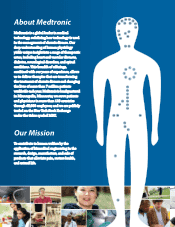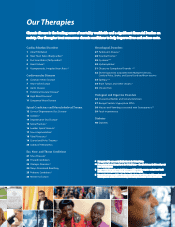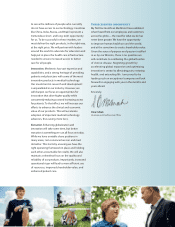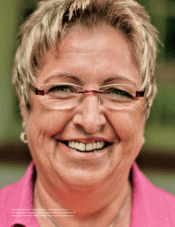Medtronic 2011 Annual Report Download - page 13
Download and view the complete annual report
Please find page 13 of the 2011 Medtronic annual report below. You can navigate through the pages in the report by either clicking on the pages listed below, or by using the keyword search tool below to find specific information within the annual report.
9
Neurosurgeons play a key role in spinal patient outcomes. Our job is to
provide them with the best-designed tools possible. Our latest spinal
products can be integrated with other advanced technologies, allowing
neurosurgeons to adapt spinal surgery for each patient while improving
the placement of implants.
I am the face of advanced care.
Our advanced spinal xation system takes neuroscience
to the next level by integrating several of Medtronic’s
core technologies. Key components include:
M
Neurosurgeons can perform spinal surgery through
small incisions rather than large incisions, resulting in
smaller scars, less blood loss, and a reduced length of
hospital stay.
B
We oer numerous sizes and strengths of rods to
help stablize the spine so neurosurgeons can select
the therapy best suited for each patient’s condition
and anatomy.
P
With some spinal surgeries lasting up to 10 hours,
powered instruments help reduce neurosurgeon
fatigue compared to manual instruments.
N
Our O-arm Surgical Imaging System provides a 3-D
view inside the patient’s anatomy, allowing surgeons
to verify screw placement during surgery. In addition,
unlike with standard uoroscopy imaging techniques,
operating sta can leave the room during image
capture to reduce their exposure to radiation.
E
Similar to barcodes, this technology provides electronic
tracking and documentation of device part and lot
numbers to support hospitals’ quality management
and patient safety eorts.
N
The system provides accurate and immediate warning
of potential harm to the patient’s critical neural
pathways, helping reduce the risk of nerve damage.
“With today’s advanced technologies, we’re able to
perform very complex procedures to realign the
spine, but that also increases the risk of compromising
nerves along the spine,” said Dr. Bradford Mullin, Senior
Neurosurgeon with Central Ohio Neurological Surgeons
and Director of Neurosurgery at Mount Carmel East
Hospital in Columbus, Ohio. “I use nerve monitoring to
give me an added degree of condence that the screws
are in the right place and there is no nerve damage.”
Another benet of nerve monitoring is with larger
patients, he added. “How they’re positioned on the
operating table can compromise peripheral nerves,
such as those near the shoulder. Larger patients
used to routinely wake up from spinal surgery with
numb hands. With nerve monitoring, I can see if their
brachial plexus is at risk and reposition their shoulder
to prevent numbness.”
























